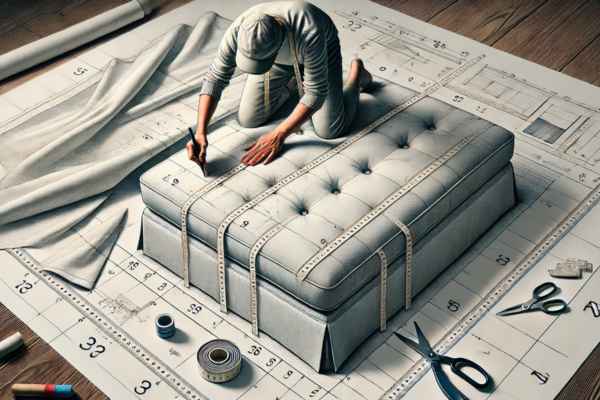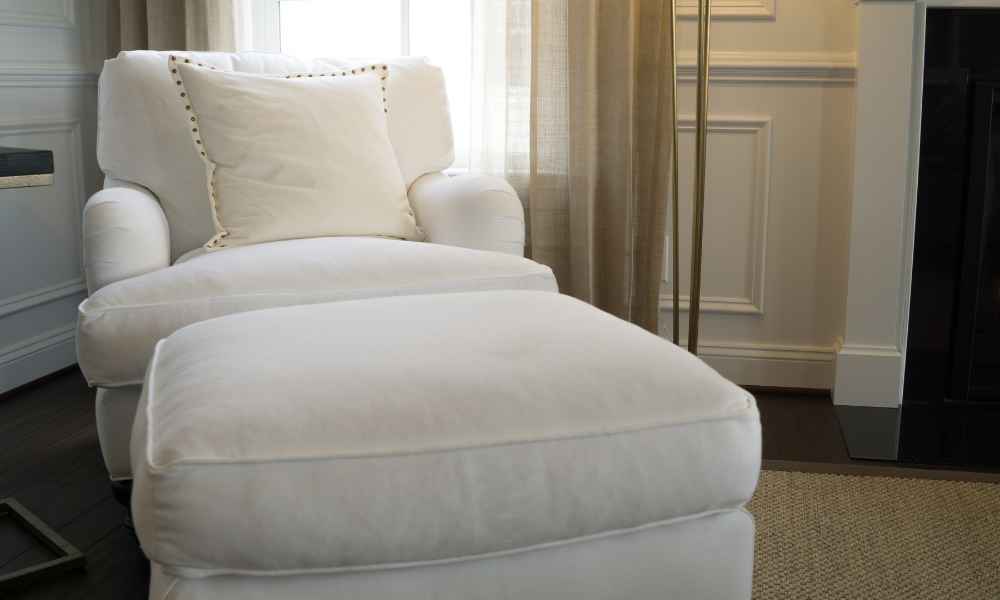Creating an ottoman cover is a simple yet effective way to refresh your living space without investing in a new piece of furniture. Whether your ottoman is showing signs of wear or you just want to change its look, a custom can give it a new lease on life. Not only does it protect your ottomans from further damage, but it also allows you to express your personal style through fabric choice and design. This guide will walk you through the process of making an ottoman cover, from understanding your ottoman’s dimensions to selecting the right fabric and executing the sewing process.
Understanding Your Ottoman

Before you begin making your ottoman cover, it’s crucial to understand the structure and dimensions of your ottoman. Ottomans come in various shapes and sizes—square, round, rectangular, and even irregular shapes. Carefully measure the height, width, and depth of your ottoman, taking into account any unique features such as tufting, buttons, or attached cushions. These measurements will guide you in cutting your fabric and ensure that it fits snugly. Additionally, consider the style of your ottomans, whether it has a modern, traditional, or eclectic design, as this will influence your choice of fabric and pattern.
Preparing The Fabric

Selecting and preparing the fabric is a key step in making an ottoman cover. Choose a durable, washable fabric that compliments your room’s decor. Fabrics like cotton, linen, or upholstery-grade materials are ideal for this project. Once you’ve chosen your fabric, pre-wash it to account for any potential shrinkage, and iron it to remove wrinkles. Laying out the fabric on a flat surface, mark and cut it according to the measurements of your ottomans, leaving an extra inch around each edge for seams. If your ottoman has a pattern, ensure that the design on the fabric aligns properly when sewn together.
Making The Ottoman Cover

With your fabric prepared, you’re ready to start assembling the ottoman cover. Begin by sewing the sides of the fabric pieces together, ensuring that the seams are straight and even. If you’re making a, consider adding a zipper or Velcro closure for easy removal and cleaning. For a more tailored look, you can also add piping or trim around the edges. Once the sides are sewn, attach the top piece of fabric, making sure it fits smoothly over the ottomans without any puckering. After sewing all the pieces together, turn the cover right side out and fit it over your ottoman, adjusting as needed to achieve a polished, custom look.
Fitting The Cover

Once your ottoman cover is sewn, the next crucial step is fitting it onto the ottomans. Carefully drape over the ottoman, making sure it aligns with the corners and sides. Adjust the fabric to ensure that it sits evenly, with no wrinkles or bunching. If the is too tight, gently stretch it over the ottomans, being careful not to strain the seams. On the other hand, if the cover is too loose, consider taking it in at the seams for a snug fit. A well-fitted will enhance the appearance of your ottoman, giving it a seamless, professionally finished look.
Finishing Touches

After fitting the cover, it’s time to add the finishing touches that will elevate the overall appearance. Consider adding decorative elements such as piping, tassels, or buttons to give your ottoman a custom, designer feel. If you’ve opted for a slipcover, ensure that the closure method, whether it’s a zipper, Velcro, or ties, is securely in place and blends well with the fabric. Iron the one final time to smooth out any remaining wrinkles, and trim any loose threads. These small details can make a big difference in the final presentation of your ottomans cover, transforming it from a simple DIY project to a polished piece of decor.
Maintenance Tips
To keep your ottoman cover looking fresh and new, regular maintenance is key. Depending on the fabric you’ve chosen, you may be able to machine wash the on a gentle cycle. For more delicate fabrics, spot cleaning with a mild detergent may be necessary. Always follow the care instructions for your fabric to prevent shrinking or fading. Regularly vacuuming the cover can help remove dust and debris, keeping the fabric clean and vibrant. Additionally, rotating the ottomans periodically can prevent uneven wear and tear, ensuring that your lasts longer and continues to enhance your living space.
Troubleshooting Common Issues
Even with careful planning, you may encounter some common issues when making an ottoman. If the cover doesn’t fit as expected, double-check your measurements and seams. A that’s too tight may need to be let out at the seams, while a cover that’s too loose may require additional stitching to take it in. If the fabric puckers or doesn’t lie flat, consider resewing the seams, ensuring that the fabric is evenly distributed. In cases where the shifts or doesn’t stay in place, adding non-slip pads or Velcro strips can help secure it. By addressing these issues promptly, you can achieve a professional-looking ottomans cover that fits perfectly and enhances your decor.
Variations And Customizations
Making an ottomans cover offers numerous opportunities for personalization and creativity. You can experiment with different fabrics, patterns, and styles to create a that perfectly matches your interior decor. For a classic look, consider using solid colors or subtle patterns, while bold prints or vibrant colors can make your ottoman a statement piece. You can also customize the shape and fit of the cover by adding features like pleats, ruffles, or a skirted bottom for a more tailored appearance. If you’re feeling particularly creative, mix and match fabrics to create a two-tone or patchwork design. Customizing your ottomans allows you to reflect your personal style and adapt the piece to different seasons or trends.
Cost And Time Considerations
Embarking on a DIY ottoman cover project, it’s essential to consider the cost and time involved. The overall cost will largely depend on the type of fabric you choose and any additional embellishments. High-quality upholstery fabric can be more expensive but offers durability and a polished look. On the other hand, repurposing fabric from old curtains or tablecloths can be a cost-effective option. Time-wise, the project can take anywhere from a few hours to a couple of days, depending on your sewing skills and the complexity of the design. While making an ottomans requires an investment of both time and money, the result is a custom piece that can save you from purchasing a new ottoman, making it a budget-friendly option.
How Long Does It Take To Make An Ottoman Cover?
The time it takes to make an ottoman cover can vary depending on several factors, including your experience level, the design of the, and the materials used. For a simple, straightforward cover, an experienced sewer might complete the project in a few hours. However, if you’re adding custom details like piping, buttons, or pleats, the process could take longer, possibly extending into a full day or weekend project. Beginners might also need more time to measure, cut, and sew the fabric, especially if they encounter any challenges along the way. Regardless of the time investment, taking a methodical approach ensures that the final product is high-quality and meets your expectations.
What Fabric Is Best For Making An Ottoman Cover?
Choosing the right fabric is crucial for creating a durable and aesthetically pleasing ottomans cover. Upholstery-grade fabrics are often the best choice due to their durability and resistance to wear and tear. Fabrics like canvas, denim, or twill provide a sturdy option for that will see heavy use. For a softer, more luxurious feel, consider velvet, chenille, or microsuede, though these may require more care to maintain. If you’re looking for something easy to clean, opt for machine-washable cotton or a fabric treated with a stain-resistant finish. The fabric you choose should not only complement your decor but also meet your practical needs in terms of durability and maintenance.
Conclusion
Making a cover is a rewarding project that allows you to refresh your furniture and showcase your personal style. With a variety of fabrics and customization options available, you can create a that perfectly fits your space and meets your needs. While the project requires some time and effort, the end result is a cost-effective and unique piece that can transform the look of your ottomans. By carefully selecting your materials and taking the time to measure and sew accurately, you can achieve a professional-quality cover that enhances your living space and provides lasting enjoyment.
